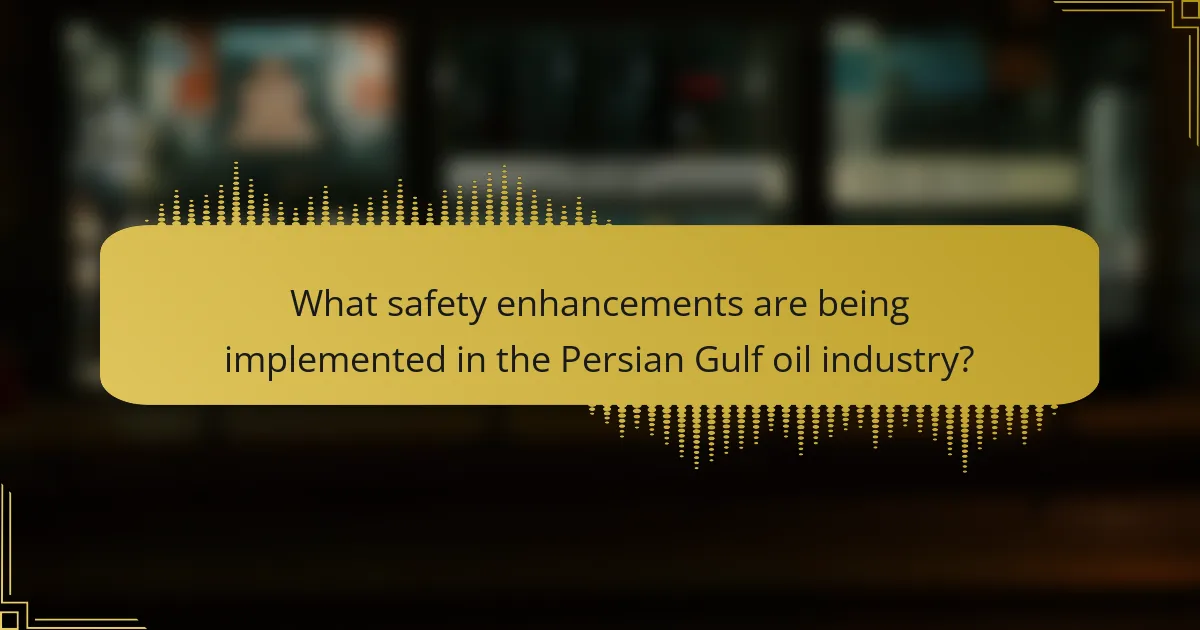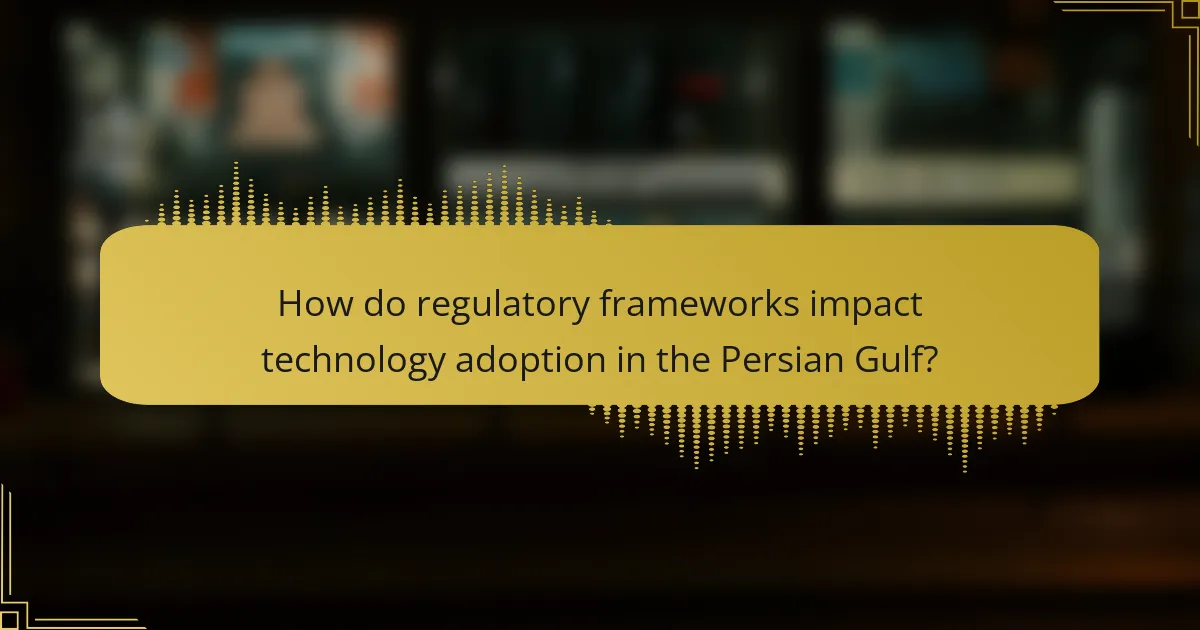The Persian Gulf oil industry is experiencing a transformative shift through the integration of advanced technologies that enhance operational efficiency, safety, and transparency. By optimizing processes and implementing automated systems, companies are achieving significant efficiency gains, reducing costs, and improving resource management. Additionally, a strong focus on safety enhancements ensures the protection of workers and the environment, fostering a more sustainable and responsible oil production landscape.

How is technology integrated in the Persian Gulf oil industry?
Technology integration in the Persian Gulf oil industry enhances operational efficiency, safety, and transparency. By leveraging advanced technologies, companies can optimize processes, reduce downtime, and improve decision-making across various stages of oil production and distribution.
Use of IoT for real-time monitoring
The Internet of Things (IoT) enables real-time monitoring of equipment and environmental conditions in the Persian Gulf oil industry. Sensors placed on drilling rigs and pipelines collect data on pressure, temperature, and flow rates, allowing operators to detect anomalies quickly.
This technology facilitates proactive maintenance and immediate response to potential hazards, significantly reducing the risk of accidents. Companies can also use IoT data to optimize resource allocation and improve overall operational efficiency.
Implementation of AI for predictive maintenance
Artificial Intelligence (AI) plays a crucial role in predictive maintenance within the Persian Gulf oil sector. By analyzing historical data and real-time inputs, AI algorithms can forecast equipment failures before they occur, allowing for timely interventions.
This approach minimizes unplanned downtime and maintenance costs, as companies can schedule repairs during non-peak times. Implementing AI-driven predictive maintenance can lead to efficiency gains of up to 20-30%, depending on the specific operations involved.
Adoption of blockchain for supply chain transparency
Blockchain technology enhances supply chain transparency in the Persian Gulf oil industry by providing a secure and immutable ledger for transactions. This allows all parties involved, from producers to distributors, to track the movement of oil and related products in real-time.
With blockchain, companies can ensure compliance with regulations and reduce the risk of fraud, as every transaction is recorded and verifiable. This transparency can lead to improved trust among stakeholders and more efficient logistics operations.

What efficiency gains are achieved in the Persian Gulf oil sector?
The Persian Gulf oil sector achieves significant efficiency gains through advanced technologies and optimized processes. These improvements translate into lower costs, better resource management, and increased production capabilities.
Reduction in operational costs
Operational costs in the Persian Gulf oil industry can be significantly reduced through the adoption of automation and predictive maintenance technologies. By implementing real-time monitoring systems, companies can identify issues before they escalate, minimizing downtime and repair expenses.
Additionally, using data analytics to optimize supply chain logistics can lead to substantial savings. For instance, streamlining transportation routes and schedules can cut fuel costs and improve overall efficiency.
Improved resource allocation
Efficient resource allocation is critical in the Persian Gulf oil sector, where maximizing output while minimizing waste is essential. Technologies such as advanced drilling techniques and reservoir management software enable companies to allocate resources more effectively, ensuring that personnel and equipment are utilized where they are most needed.
Moreover, integrating data from various sources allows for better decision-making regarding workforce deployment and equipment usage, which can lead to enhanced operational efficiency and reduced idle time.
Enhanced production rates
The integration of cutting-edge technologies has led to enhanced production rates in the Persian Gulf oil industry. Techniques like enhanced oil recovery (EOR) and horizontal drilling can significantly increase the amount of oil extracted from existing fields, thereby boosting overall production without the need for new drilling sites.
Furthermore, automation in drilling operations can reduce the time required to complete wells, allowing companies to ramp up production more quickly. This not only meets market demand but also improves the return on investment for existing assets.

What safety enhancements are being implemented in the Persian Gulf oil industry?
The Persian Gulf oil industry is adopting various safety enhancements to protect workers and the environment. These improvements include advanced training programs, automated safety systems, and regular audits to ensure compliance with safety regulations.
Advanced safety training programs
Advanced safety training programs are essential for equipping workers with the necessary skills to handle potential hazards in the oil industry. These programs often include simulations and practical exercises that reflect real-life scenarios, helping employees to respond effectively in emergencies.
Training typically covers topics such as hazard recognition, emergency response, and the use of personal protective equipment (PPE). Companies may also implement ongoing training sessions to keep staff updated on the latest safety protocols and technologies.
Deployment of automated safety systems
Automated safety systems are increasingly being integrated into oil operations to enhance safety and reduce human error. These systems can monitor equipment conditions, detect leaks, and trigger alarms in case of emergencies, allowing for quicker responses.
For instance, many facilities now utilize advanced sensors and monitoring technologies that provide real-time data on operational parameters. This proactive approach helps in identifying potential risks before they escalate into serious incidents.
Regular safety audits and compliance checks
Regular safety audits and compliance checks are critical for maintaining high safety standards in the Persian Gulf oil industry. These audits assess adherence to safety regulations and identify areas for improvement, ensuring that companies meet local and international safety requirements.
Typically, audits are conducted by internal teams or third-party experts who evaluate safety practices, equipment functionality, and employee training. Following these assessments, companies can implement corrective actions to address any identified deficiencies, thereby enhancing overall safety performance.

What are the key challenges in technology integration for oil companies?
Key challenges in technology integration for oil companies include high initial investment costs, resistance to change within organizations, and the need for a skilled workforce. Addressing these challenges is crucial for improving efficiency and safety in the Persian Gulf oil industry.
High initial investment costs
High initial investment costs can be a significant barrier to technology integration in the oil sector. Companies often face substantial expenses when adopting new technologies, including equipment, software, and infrastructure upgrades. These costs can range from hundreds of thousands to millions of dollars, depending on the scale of the integration.
To mitigate these costs, oil companies can explore financing options, such as partnerships or government grants, which may help spread the financial burden. Additionally, conducting a thorough cost-benefit analysis can assist in justifying the investment by highlighting potential long-term savings and efficiency gains.
Resistance to change within organizations
Resistance to change is a common challenge in many organizations, including oil companies. Employees may be hesitant to adopt new technologies due to fear of job loss, lack of familiarity, or perceived complexity. This resistance can slow down the integration process and hinder overall productivity.
To overcome this challenge, companies should prioritize change management strategies. Providing training sessions, clear communication about the benefits of new technologies, and involving employees in the decision-making process can help foster a more accepting culture towards technological advancements.
Need for skilled workforce
The need for a skilled workforce is critical for successful technology integration in the oil industry. As new technologies emerge, companies require employees who are proficient in operating and maintaining these systems. This demand for skilled labor can create a talent gap, particularly in specialized areas such as data analysis and automation.
To address this issue, oil companies can invest in training programs and partnerships with educational institutions to develop a pipeline of qualified candidates. Additionally, offering competitive salaries and benefits can attract skilled professionals to the industry, ensuring that companies have the necessary expertise to implement and sustain new technologies effectively.

How do regulatory frameworks impact technology adoption in the Persian Gulf?
Regulatory frameworks significantly influence technology adoption in the Persian Gulf oil industry by establishing standards that companies must meet. These regulations can either facilitate or hinder the integration of new technologies, depending on how they align with industry goals and environmental considerations.
Compliance with environmental regulations
Compliance with environmental regulations is crucial for oil companies operating in the Persian Gulf. These regulations often dictate the technologies that can be used, especially those related to emissions control and waste management. For instance, companies may need to invest in advanced flaring reduction technologies to meet strict emission standards.
Failure to comply can result in hefty fines and operational shutdowns, making it essential for firms to stay updated on local regulations. Regular audits and assessments can help ensure compliance and identify areas for technological improvements.
Influence of government policies on innovation
Government policies in the Persian Gulf play a pivotal role in fostering innovation within the oil sector. Policies that incentivize research and development can lead to the adoption of cutting-edge technologies, such as digital oilfield solutions and automation systems. For example, subsidies for renewable energy projects can encourage oil companies to diversify their technology portfolios.
Conversely, restrictive policies may stifle innovation by limiting the types of technologies that can be implemented. Companies should actively engage with policymakers to advocate for regulations that promote technological advancement while ensuring safety and environmental protection.
